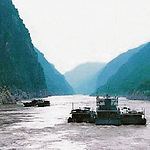First some key figures. The project consisted of the construction of the dam with the crest at 185 metres above MSL (mean sea level). The dam is a maximum of 181 metres high and 2.3 kilometres long. In addition, a complex with two staircases of five locks each and a ship lift were built. The dam was mainly intended for energy supply, flood control and improved shipping. Construction started in 1993 and the dam was ready for use in 2009. In 2005, the first electricity could be generated.
26 turbines were installed in the dam with a total capacity of 18,200 megawatts. At the time, this was enough to supply 10% of the total energy supply for China. In the meantime, energy consumption in China has increased to such an extent that this percentage will in any case be significantly lower. In order to be able to discharge excess water and sediment during the wet season, enormous emergency outlets have been installed. These are placed at two levels, namely 23 more or less halfway up the dam and 22 more or less at the crest. The ship locks are each 280 metres long and 34 metres wide, allowing ships of 10,000 tonnes to pass through the five ship locks in two and a half hours.
The dam itself contains some 16 million cubic metres concrete. With this, it far exceeded, as our guide proudly told us, the then second largest dam, which was apparently located in Russia. That dam contained only 6 million cubic metres concrete. We were also presented with many other figures, all of which far exceeded what had been achieved elsewhere.
In addition to the incredible size of this project, a number of other aspects are very interesting and some of them were also controversial. For example, in connection with the 1,084 square kilometres reservoir that was to be created behind the dam, some 1.3 million people had to be relocated. Because the outspokenness of the population in China was also rapidly increasing, the government had made extensive provisions for this and made serious efforts to arrange this properly.
A major technical problem was the silt in the river water. At that time, the Yangtze River was the third largest river on earth in terms of silt content. Very extensive model tests had been carried out to design the dam in such a way that as much silt as possible could be removed. Nevertheless, it was taken into account that the reservoir would be silted up after about 80 to 130 years.
Finally, the environmental aspects naturally played a major role and the scientists would never agree on this. There was a great deal of criticism on the project in this regard, especially from the Western world, because the dam cut through the main stream of Yangtze River. To my surprise, however, we also visited the Gezhouba Dam, which had been located 37 kilometres downstream in the Yangtze River since 1986. The ‘evil’ of damming the main stream had therefore already been done long ago. The sturgeon, which lives most of the time in the sea, but swims up the Yangtze River once every three to five years to mate and lay eggs (caviar), proved to be particularly important to the Chinese. The fishes were caught in front of the dam at that time and transferred. I assume that a better provision has been made in the meantime.
The openness that was shown on the project was striking. Until a few years ago, these kind of projects were almost always forbidden areas, and if you were allowed to visit as an exception, you were certainly not allowed to take pictures. During our visit, we were allowed to view the project at all kinds of relevant locations and everything could be photographed. In this respect, China had at that time increasingly opened its doors to the outside world.




